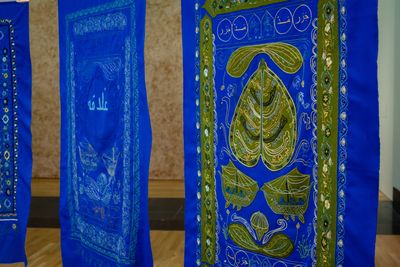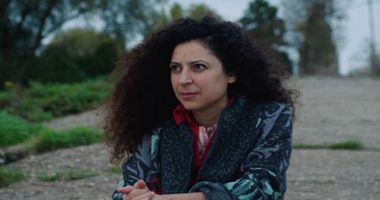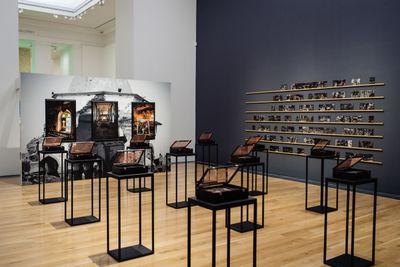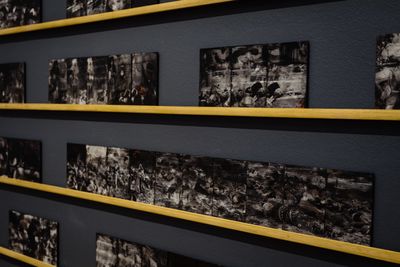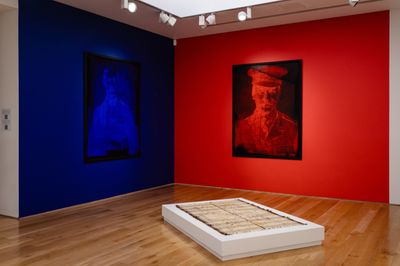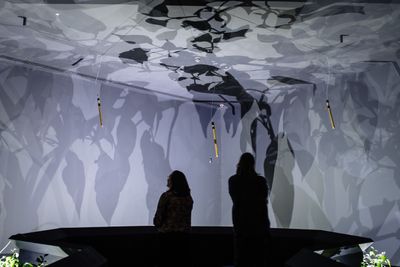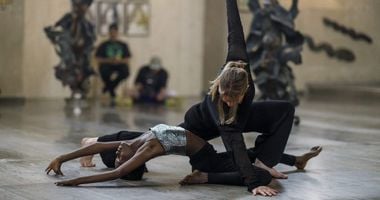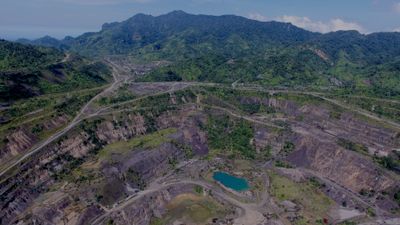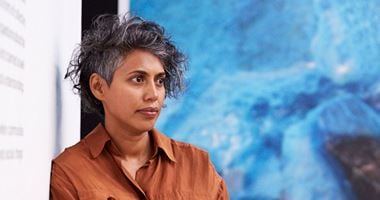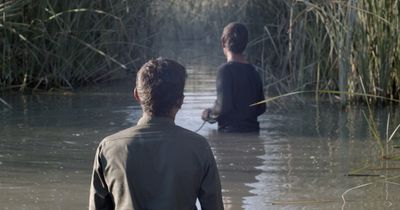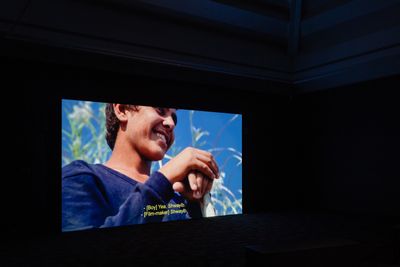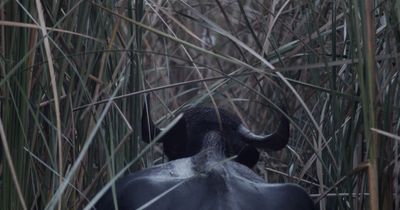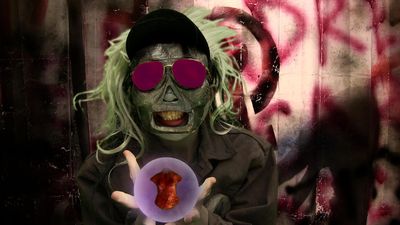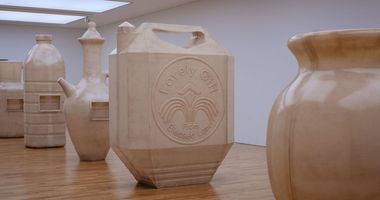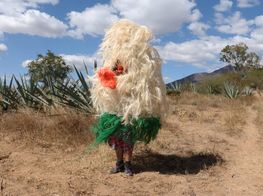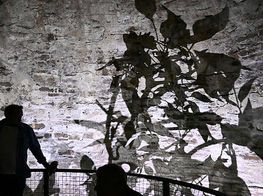At Artes Mundi, Artists Call for Peace
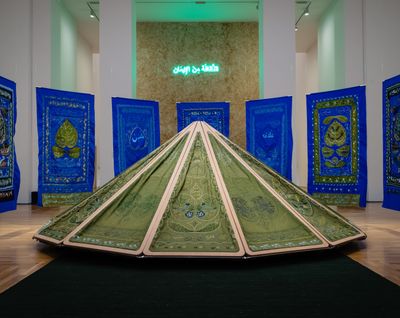
Mounira Al Solh. Exhibition view: Artes Mundi 10, National Museum Cardiff, Wales (20 October 2023–25 February 2024). Courtesy AM10. Photo: Polly Thomas.
It hasn't been easy to talk about art since Hamas launched an attack on southern Israel on 7 October, prompting an ongoing retaliation by the Israeli Defence Forces.
By the time the biennial Artes Mundi award exhibition opened in Wales on 20 October, with a tenth anniversary edition staged in five venues across the country for the first time, the siege and bombardment of Gaza was nearing two weeks.
'It's been intense,' artist Mounira Al Solh admitted, standing by her works at the National Museum Cardiff. 'This is bringing back trauma from Sabra and Shatila, and I wish for the killing on all sides to stop.'
Al Solh was referring to a massacre in 1982 amid the Lebanese Civil War, when the occupying Israeli army allowed a Lebanese militia to enter Palestinian refugee camps in Beirut. Scores were killed; mostly women, children, and the elderly.
Sabra and Shatila is among the Lebanese Civil War's deadliest events. As Al Solh pointed out, its memory lingers, along with others that have rocked the region where she was born and raised. Among the works Al Solh is showing in Cardiff is 'I strongly believe in our right to be frivolous', an ongoing drawing series initiated in 2012 after the civil uprising in Syria escalated into civil war, forcing many to cross the border into Lebanon.
Al Solh, who is of Syrian and Lebanese descent, wanted to welcome these refugees. She invited them into her studio in Beirut to sit for portraits that are mostly drawn on a yellow legal pad, which include notations of things they discussed.
The intimate space Al Solh holds for personal experiences of war and displacement finds community with works by Rushdi Anwar in the next room. On one wall, seven rows of black-and-white photographs reference the 1988 massacre of Halabja, Anwar's hometown in the Kurdistan Region of northern Iraq. Marking the start of Iraqi president Saddam Hussein's genocidal campaign against Kurdish people, war planes dropped napalm, mustard gas, and other nerve agents on Halabja during the Iran-Iraq War, violating international law. Fourteen members of Anwar's family were among the estimated 5,000 people who died.
Titled A Few Lines of History (2011), the images appear in various states of obfuscation due to interventions with smoke. They are arranged along shelves like morse code—an approach that defies the simplification of historical events into legible mainstream narratives.
The United States supported Iraq in its war against Iran, after all, and as declassified CIA documents have since reportedly revealed, was aware of Iraq's illegal misuse of chemical weapons. Yet, as Anwar argues, the issue did not become a point of moral contention until it suited U.S. foreign policy—in particular, the invasion of Iraq in 2003, which former UN Secretary General Kofi Annan once described as illegal, with Hussein later charged with genocide.
'The whole project looks at the hypocrisy of politics,' Anwar explained, gesturing towards a second room. There, archival displays tracking the colonisation of the region historically known as the Middle East are presented alongside two black-and-white portraits printed on a map over a monochromatic ground. A blue print shows French diplomat François Georges-Picot; a red one depicts his British counterpart, Mark Sykes.
Both were architects of the 1916 Sykes-Picot Agreement that divided the Ottoman Empire's lands between the U.K. and France. Borders were apparently drawn on a map with a ruler, paying little attention to the cultural, territorial, and tribal realities on the ground. As Iraqi governor Nawzad Hadi Mawlood noted in 2016, 'Hundreds of thousands have been killed' as a result.
Including those in Israel and Palestine. The Sykes-Picot Agreement led to the British mandate of Palestine, and was followed by the 1917 Balfour Declaration, which paved the way for the establishment of the state of Israel in 1948, otherwise known as the Palestinian Nakba.
The title of this body of work, 'A Hope and Peace to End All Hope and Peace' (2023–ongoing), is certainly fitting when thinking about this historical continuity—both in terms of the current moment and for the Artes Mundi project in general. Founded in 2002, the award supports artists from around the world who explore the complex textures of the human condition.
At Glynn Vivian Art Gallery in Swansea, Nguyễn Trinh Thi's And They Die a Natural Death (2022), first presented at documenta fifteen, invites audiences into a dark room where the shadows of chilli plants are projected onto the walls. Hanging from the ceiling are custom-built bamboo flutes, which are activated by a system that transforms live wind data from a sensor in Tam Đảo forest in northern Vietnam.
The composition references a moment in Vietnamese writer Bùi Ngọc Tấn's autobiographical novel Tale Told in the Year 2000. When, in a detention camp in Tam Đảo in the 1960s and 70s—around the time of the Vietnam War, a defining conflict of the Cold War—a guard kills an elderly prisoner for picking chillis.
At Mostyn in Llandudno, Taloi Havini's three-channel video Habitat (2017) foregrounds another crime scene. Travelling through the artist's homeland of the Autonomous Region of Bougainville in Papua New Guinea, the camera tracks the environmental devastation caused by the Panguna copper mine, marked by an uncanny electric-blue copper sulphate run-off that continues to poison earth and water.
Panguna was operated by the British-Australian company Rio Tinto from 1972 until its closure in 1989, spurred by an uprising in 1988 when the local community attacked the mine's power lines, extraction equipment, and water supplies. A civil war between the peoples of Bougainville and the Papua New Guinea government erupted as a result, effectively culminating in a peace agreement in 2001.
War is a connecting thread across AM10. Back at National Museum Cardiff, Alia Farid's In Lieu of What Is (2022) comprises five monumental water vessel sculptures cast in off-white fibreglass and polyester resin, fabricated in the style of public drinking fountains common across Kuwait. Each sculpture, from a jerry can to a South Asian lota, is rooted in the politics of water and oil that have shaped the region.
As Farid notes, Kuwait used to get its freshwater from Basra in Iraq, where Farid's paternal grandmother is from, until the discovery of oil led to the establishment of Kuwait's first desalination plant in 1951, ten years before the state gained independence from Britain.
In another room, the single-channel film Chibayish (2023), which follows the lives of Indigenous Marsh Arab children in Southern Iraq's ancient wetlands, speaks to what happened after that discovery.
After the Iran-Iraq War, the Marsh Arabs were accused of harbouring Shi'a rebels and insurrectionists by Saddam Hussein. In retaliation, Hussein drained and dammed its waters in the early 1990s—around the time Iraq invaded Kuwait and set fire to its oil fields—causing what Farid describes as a crime against nature.
While efforts have been made to restore the marshes, factors including war, climate change, dam-building, and development have impacted their recovery. Still, Farid's film, which the artist describes as 'emergent', focuses on life. There was no script. Rather, Farid was led by those she filmed. The result is an intimate view of life in a watery domain. Young boys introduce their community; children play in the water and dance at night by the fire.
In one mesmerising scene, boys stand amid the reeds and call out to their buffalo in a melodic threading of guttural sounds and Arabic—the expression, Farid says, of a 'reciprocal relationship whereby both buffalo and human understand that their livelihood depends on each other'.1
Interspecies reciprocity continues in Carolina Caycedo's 12-minute video, Reciprocal Sacrifice (2022), showing at Oriel Davies Gallery in Newtown. Narrating footage of its migration, a Chinook salmon recounts a long-forgotten commitment where salmon agreed to nourish humans so long as they nurtured the waters they depend on.
Reciprocal Sacrifice is partly narrated in Niimiipuu, the language of the Nez Perce Tribe of Idaho, who are working to revive Niimiipuu in an effort to reclaim what settler colonialism almost erased. That effort mirrors the group's struggle to undam the Snake River, which crosses the Pacific Northwest. These dams have endangered the salmon's survival by disrupting migration cycles, the salmon explains in Reciprocal Sacrifice, imploring humans to remember the connection they once shared.
Naomi Rincón Gallardo's 'Tzitzimime Trilogy' (2021–2023) amplifies that urgent reminder at Chapter in Cardiff, with psychedelic films that tap into the stories of the Tzitzimime: sharp-toothed Mesoamerican demons known to visit Earth during solar eclipses.
Oscillating between punk DIY aesthetics and striking, occultist cinematography (think Kenneth Anger and Mike Kelley), each film is a riotous mash-up of old and new, real and fantastical, animal and human. Set in the toxic aftermath of a post-extractionist apocalypse, Sonnet of Vermin (2022) tells the survival tale of mutants, with faces painted fluorescent pinks, oranges, and blues, wearing helmets constructed from wire and foil. In Verses of Filth (2021), figures dressed as a scorpion and bat dance gleefully in a dive bar.
In Gallardo's world, the will to live is enough to create life after catastrophe: a resolve that connects the artists nominated for AM10, who each hold space for necessary discussions around the histories that bear down on the present.
On the opening night, in fact, the artists delivered a collective statement. 'Our diverse voices have in common a need to tell and create worlds that oppose the ongoing legacies of colonialism, imperialism, racism, extraction, and the militarisation of the planet,' they said, calling for a ceasefire and 'joint efforts for peace.' —[O]

